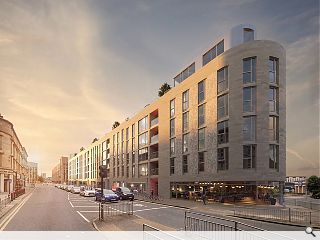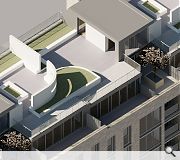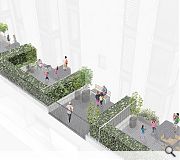Westpoint Homes fight back against Finnieston planning refusal
May 24 2021
Westpoint Homes have revisited their plans for a major apartment complex at the former Cranstonhill Police Station in Finnieston with moves to improve amenity, privacy and access.
Led by Norr and Erz the work called for the demolition of the vacant police station at 945 Argyle Street to build 84 flats above six ground floor commerical units but was dismissed because it would impede daylight and privacy of neighbours and was deficient in open space. Planners also voiced concern at the loss of a tree to the west, proximity of service access to a busy junction and the fact that 16 flats had no direct access to refuse storage or cycle parking.
Responding to this feedback the applicants have now returned with significant changes made to the original March 2020 application; notably a shared amenity deck at roof level and a reduction in massing towards the centre of the building.
Addressing the proposed amendments the applicant wrote: "The key matters discussed with GCC during the post-submission period relate to the building’s mass concerning the proximity of the neighbouring Minerva Court building on the south side of Houldsworth Lane. In addition, the tight urban site restricts opportunities to provide high-quality amenity space which complies with IPG12 (interim planning guidance) requirements.
"This, in turn, touches on landscaping proposals and a need to show a well-considered and meaningful design for the areas of amenity which are proposed. Finally, any reduction in building mass will effectively reduce flat numbers which will result in reduced pressure on amenity, car parking and daylighting."
As a result of these changes, the number of flats offered is reduced from 84 to 78 while Houldsworth Lane will remain open to all, not gated as originally envisioned.
|
|
18 Comments
Surely when people buy a high-density inner-city flat they accept that amenities are generally external to the flat. A 5 minute walk to the park, 3 mins to a train station, 3 minutes to a gym & swimming pool, 1 minute from a supermarket, bus on the street....
If they want a private garden or outdoor space they can move to Airdrie.
That said, the shared roof space seems a reasonable compromise.
It could be a real showpiece if it is greened and made more urban.
Consequently the traffic on the street will be a lot different from now.
#5 an electric car is still a car? I mean I hope it will be different in that there will be fewer private motorised vehicles but I doubt it. The cynic in me says it'll be the same or worse without the necessary action taken to discourage car use in our urban centres.
Finnieston is a prime example of an area that needs urgent action to restrict/ban through traffic (except buses and perhaps taxis) and improvement to pedestrian space/cycle infrastructure. So many great pubs/bars and restaurants in such a short stretch, hemmed in by near constant traffic and lines of parked cars on either side. Not a terribly nice place to sit out for a drink or lunch/dinner.
Finnieston Street is a major transport artery into the West End - this and the connection to the expressway there are unlikely to change. Also one of the key reasons there are so many commercial premises there is due historically to that passing trade and ease of access. Hopefully that will not change. Electric cars will mean less smoke pollution but the noise can only be reduced a little. More high quality streetscape (Shawlands, Rutherglen etc) would definitely benefit the place though.
The only thing I did find terrible was if there was a manhole on the street next the flat, if the manhole covers were slightly lower than the road it would send vibrations up through the flats when an HGV drove over them, also some times the manhole covers would clatter.
I would avoid getting a flat next a road with manhole covers next the flats, I can't see any next this scheme though.
It is strange that they put manhole covers over to the side of the road where vehicle wheels will drive over them all the time, if they put them in the middle of the lane in so that vehicle wheels would pass either side of them there would be no noise. Also vehicles driving over them makes them slowly collapse, so it just makes no sense that they install them over to side where they will be driven over instead of in the middle where they won't.
As regards the comments about cars/ electric cars, they are the same thing a vehicle occupying road space. If anything I expect to see even more vehicles on the road with the possibility of small electric city cars and larger ex urban cars, also last mile delivery vehicles will proliferate. Not to mention ride sharing vehicles be they human operated or autonomous.
How is it that many other developments get approved that cause a similar loss of sun light and privacy? There seems to be no loss of privacy/light building standards that developers can follow, the standard just seem to as per the whim of the planning officials.
If flats didn't get build because they caused a loss of privacy and light there would be no flats in Glasgow, it is part and parcel of living in a city that people can see in other flat windows.
Windows In The West by Avril Paton is a famous Glasgow painting showing the view looking in other people's flat windows in Glasgow, planners today must really hate that painting, they don't what people to be able to see in any other windows.
It might get smaller / it might get simpler and lighter but it is here to stay.
If you have issues with the traffic then what are they -- noise / emissions / safety?
Or do you just not like cars and subscribe to the "Hame'll dae me" theory of life?
When the tenements across the rod were built the huge plague of the streets of Glasgow was horse manure -- things change / get used to it.
Elevations look good, however, some detailing to the stone would help with the masonry panels. They look very flat and will only weather badly.
Post your comments
Back to May 2021
Like us on Facebook
Become a fan and share





